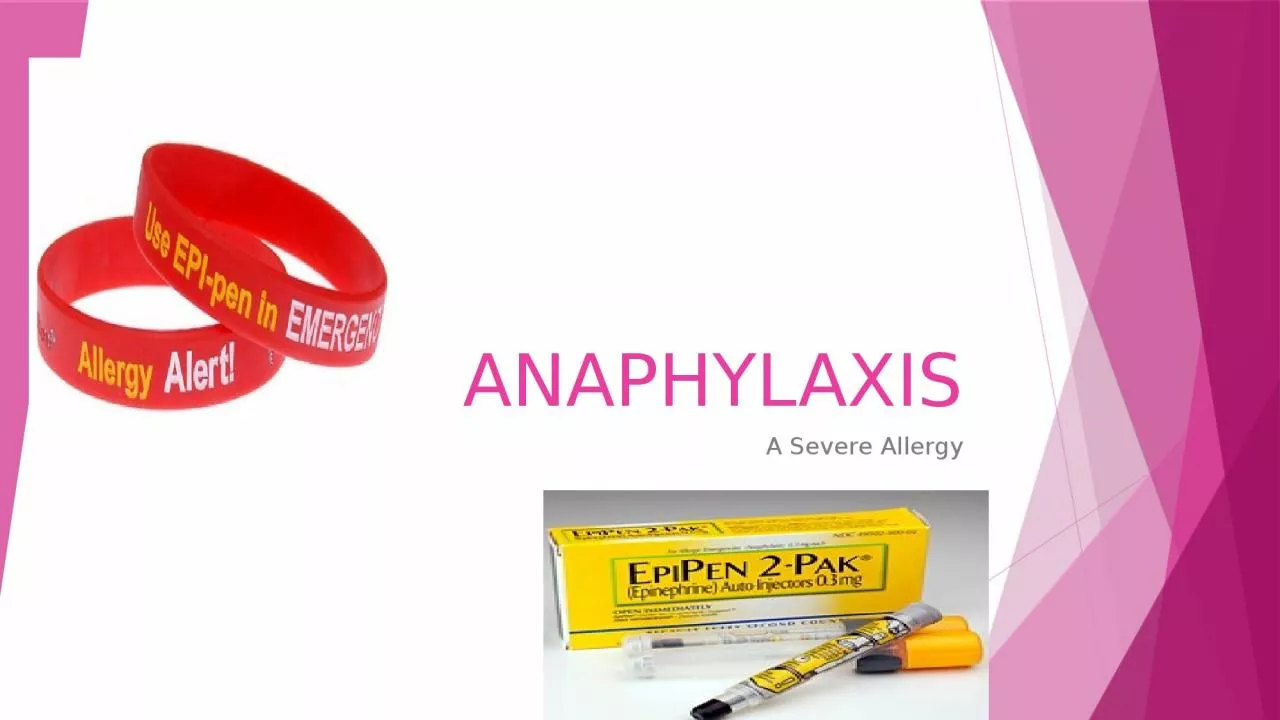

Arizona School Access to Emergency Epinephrine Act SB1421 Passed on September 24 2013 What does it mean for our schools Requires training of all staff in the Recognition of the Symptoms of ANAPHYLAXSIS and How to Provide Assistance ID: 919818
Download Presentation The PPT/PDF document "ANAPHYLAXIS A Severe Allergy" is the property of its rightful owner. Permission is granted to download and print the materials on this web site for personal, non-commercial use only, and to display it on your personal computer provided you do not modify the materials and that you retain all copyright notices contained in the materials. By downloading content from our website, you accept the terms of this agreement.
Slide1
ANAPHYLAXIS
A Severe Allergy
Slide2Arizona School Access to Emergency Epinephrine Act
(SB1421) Passed on September
24, 2013 What does it mean for
our schools?
Requires training of all staff in the Recognition of the Symptoms of ANAPHYLAXSIS and How to Provide Assistance
Allows
schools to stock and administer auto-injectable
epinephrine
and
protects trained staff members from civil liability
Allows training of non nurse staff members
in the administration of auto-injectable epinephrine
Slide3Allergies occur when the immune system becomes
unusually
sensitive and overreacts to common substances that are normally harmless. Examples are:
Foods
– peanuts, tree nuts, sesame seeds, milk eggs, seafood, soy, wheat,
sulphites
and mustard Insect bites – bees, wasps, hornets and some ants Medications – penicillin, sulfa drugs Exercise Latex – gloves/medical devices
WHAT IS AN ALLERGY?
Slide4WHAT IS ANAPHYLAXIS?
Occurs when a person is exposed to an allergen causing a
severe, life-threatening allergic response Reactions occur within minutes or, more rarely, up to a few hours after exposure
Slide5SYMPTOMS of ANAPHYLAXIS
Skin
– hives , swelling, itching, warmth, redness, rash Respiratory (breathing) – wheezing, shortness of breath, throat tightness, cough, hoarse voice, chest pain/tightness, nasal congestion or hay fever-like symptoms (runny itchy nose and watery eyes, sneezing), trouble swallowing Gastrointestinal (stomach): nausea, pain/cramps, vomiting, diarrhea Cardiovascular
(heart): pale/blue
color
, weak pulse, passing out, dizzy/lightheaded, shock
Other
: anxiety, feeling of “impending doom”, headache, uterine cramps in females, metallic taste
Slide6How a student may describe symptoms of Anaphylaxis
This food is too spicy
My tongue is hot (or burning)It feels like something is poking my tongueMy tongue (or mouth) is tingling (or burning)My tongue (or mouth) itchesIt (my tongue) feels like there is hair on it
My mouth feels funny
There’s a frog in my throat
There’s something stuck in my throat
My tongue feels full (or heavy)
My lips feel tightIt feels like there are bugs in there (to describe itchy ears)It (my throat) feels thickIt feels like a bump is on the back of my tongue (throat)
Slide7Why Are Our Students At Higher Risk?
Increased
independence Increased risk taking behavior ‘invincible’Eating unsafe food, sharing food, and eating out Not
carrying auto
injector-( lack insurance coverage, $, understanding, etc.)
The
part of the brain that makes decisions is the last to mature
Not telling friends, wanting to fit in or Their first exposure/ reaction occurs at school *One in 13 kids has a food allergy and 25 percent have their first reaction at school
Slide8People with a risk of risk of
ANAPHYLAXIS are taught to follow the THREE
A’S: Awareness
Know
the triggers
Know
the emergency plan and how to administer epinephrine via the auto-injector
AvoidanceAvoid contact with allergensAction Give auto-injector and call 911. Don’t delay!
Slide9What Should
I Do?
Be aware of students who have a risk of ANAPHYLAXIS in your classroom/schoolRecognize the symptoms Allow student to administer single dose auto-injectorCall the Security/Nurse
***Call 911 if you cannot reach someone immediately
*
Epinephrine is the only way to reverse the effects of anaphylaxis.
Must be given
ASAP *Epinephrine may only last for 15 minutes, calling 911 is very important
Slide10How Can I Help AFTER The Student Uses Their EPI PEN And Before Help Arrives?
If
dizzy or faint have student lie down If nauseated or vomiting, have the student lie on their side to prevent choking
If breathing is
difficult the student may
sit up
Loosen tight clothing and cover student with blanket Don’t give the student anything to drink Do Not Leave the Student Alone!
Slide11The End